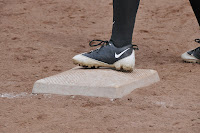Today's cameras are incredible electronic tools. They can do many things that more expensive and larger digital SLR's can't. Well, they can but it requires more technical expertise to do so.
Since it is so near the holiday's and so many people are planning to buy a new camera I thought it wourld be helpful if I offered a simple tip that might help you choose which camera is right for you. I spent some time in a local department store with an electronics department that contained several brands of cameras on display. One thing I should mention is that most of these will have very comparable image quality. As a matter of fact if you don't make prints larger than 8" X 10" they are virtually the same.
So if they all give the same quality image then how do you choose? There is a simple test you can do in the store. You should do this before talking to any clerks or sales people. Look the camera over and see how it feels in your hands. The controls should be easy to reach and easy to understand. Most cameras nowadays have very few outside buttons on them. You should have an on/off button, and a "W/T" button for wide angle or telephoto views. Another button will turn on the menu options. If these are easy to find and operate, continue checking out the camera by taking a couple of pictures of something or someone in the store. Was it easy to do without having to figure out how it works? If so your still on good ground so keep going. Somtimes a message will pop up telling you the internal memory is full. If this happens try to delete the pictures on the camera. It's OK, its a demo model you are using and you need to know how to do this. If this is easy to do keep going. The camera may or may not have a button for viewing images and some have delete buttons on the outside too.
Next you need to open the camera's menu and find out how easy it is to change the settings. If this is easy for you to understand, you have found a good camera for you. There will probably be several models of the same brand at different prices. The higher the price the more options and pixels. Only buy the more expensive cameras if you will use the options offered, if you won't then save your money for a tripod. If you can figure out how to operate the camera without the help of the clerk then it is a good bet you will be happy with it later.
I found the menu's of Sony, Fugi, and Nikon to be the easiest for me to navigate. Olympus was available but I didn't get to handle it at the time I was there. Canon is an excellent brand but I had a hard time decifering it's menu system. Once you have become comfortable with the camera you like talk to the clerk if you need to, or if you have questions but don't let them talk you into something you find complicated or hard to operate. After all the clerk isn't going to be shooting your pictures for you.
Good luck and have fun. Once you have your new camera check out my older posts to learn how to use it.
Please send comments if this article was helpful to you or if you would like information about other topics.
I have created a great little book store called "How To Use Your Camera" where you can buy photography books online. Just click the link to see what is available.
If you need a camera get it here at my camera store at "Photo To Go"
You can also visit my own photography website at Dwains Picks to see some of my work.
Thanks for visiting and I hope you will check this site often.


















